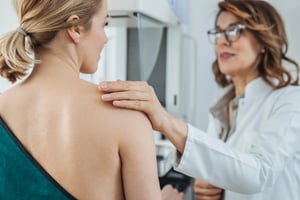 Did you know that breast cancer is the second most commonly diagnosed cancer for women in the United States? It only trails skin cancer and can develop in both men and women, however, it is far more common in the latter. When cells in the breast begin to grow abnormally and divide more quickly, they can rapidly accumulate, creating a mass or lump in the breast. These abnormal cells can metastasize throughout the breast and spread to the lymph nodes and other areas of the body. Let’s take a close look at the signs, causes, and other details of breast cancer.
Did you know that breast cancer is the second most commonly diagnosed cancer for women in the United States? It only trails skin cancer and can develop in both men and women, however, it is far more common in the latter. When cells in the breast begin to grow abnormally and divide more quickly, they can rapidly accumulate, creating a mass or lump in the breast. These abnormal cells can metastasize throughout the breast and spread to the lymph nodes and other areas of the body. Let’s take a close look at the signs, causes, and other details of breast cancer.
What are the Causes of Breast Cancer?
Breast cancer typically presents itself in the milk-producing ducts, known as invasive ductal carcinoma. However, it can also be in the lobules or glandular tissue. There are several environmental, lifestyle, and hormonal factors that can increase the risk of breast cancer. Breast cancer is widely believed to be caused by a complex interaction of genetic and environmental variables. A strong family history of breast cancer, referred to as inherited breast cancer, is another significant contributor. Inherited mutated genes, BRCA1 and BRCA2 cannot only enhance the chance of breast cancer but also ovarian cancer.
What are the Symptoms of Breast Cancer?
There are several signs and symptoms that can indicate breast cancer. These symptoms include a newly developed inverted nipple. Changes in the shape, size, appearance, or skin texture of the breast can also signal the development of breast cancer. Skin changes like pitting or redness on the breast’s skin, as well as flaking, crusting, scaling, or peeling of the areola are also common breast cancer symptoms. One of the most common indicators is a lump in the breast, or a thickening of an area that feels different than the other breast tissue.
What are the Risk Factors of Breast Cancer?
Breast cancer risk factors are defined as anything that increases your likelihood of developing it. However, you can have one or even several risk factors and never be diagnosed with breast cancer; at the same time, you can have no known risk factors and develop breast cancer. A family history combined with females of increasing age makes patients the most susceptible to experiencing this type of cancer. Furthermore, obesity, radiation exposure, advanced age pregnancies, and alcohol use can lead to higher rates of a breast cancer diagnosis.
How is Breast Cancer Treated?
Breast cancer treatment is determined by a variety of factors. The type, stage, grade, size, and hormone sensitivity are all key considerations when your doctor designs a treatment plan. Breast cancer surgery is done in different stages based on the spread of breast cancer. A lumpectomy removes the cancerous mass and is performed to conserve the breast. A mastectomy involves removing the entire breast. Axillary lymph node dissection removes several lymph nodes that are cancerous.
Radiation and chemotherapy are also proven treatment methods that can kill cancerous cells. Radiation therapy uses high-powered beams of radiation to target and eradicate the cancer. Chemotherapy utilizes drugs to destroy rapidly growing cells. This is effective in mitigating the return or spread of breast cancer.
How Can Breast Cancer be Prevented?
Your risk of developing breast cancer can be drastically reduced through lifestyle changes as well as with annual screenings. Lifestyle changes include minimizing alcohol consumption, exercising, and limiting postmenopausal hormone therapy. You should also consult your doctor about breast cancer screening exams and tests and perform self-exams to ensure there are no new changes like lumps and other unusual signs in your breasts.
The expert staff of doctors and nurses in the OB/GYN department at Lane Regional Medical Center is here to help with all of your health needs.




.png?width=110&height=110&name=lane%20badge%20(1).png)
